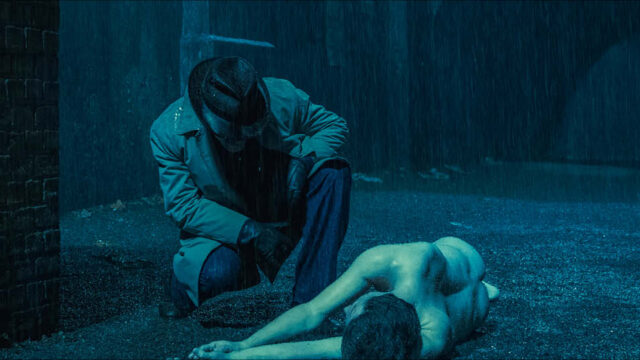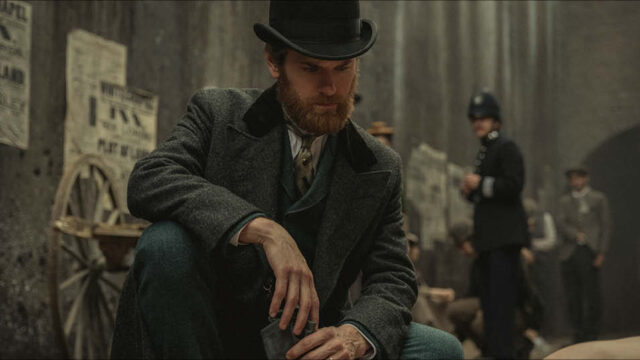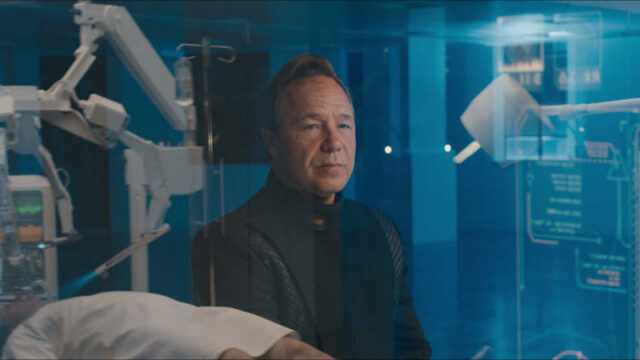For new Netflix drama, Bodies, Moonage found itself making a period romance, a noir thriller, a police procedural and a dystopian sci fi, all at the same time. Jon Creamer reports
Moonage Pictures’ upcoming Netflix drama, Bodies, a series based on the graphic novel by Si Spencer, is a crime thriller with quite a twist. In the show, a body – the same body – is found on Longharvest Lane in London’s East End in 1890, 1941, 2023 and 2053. One detective from each period must investigate. To solve the mystery, four detectives must somehow collaborate and uncover a conspiracy spanning over 150 years.

For the production, that meant creating a show with four distinct looks across four distinct time periods whilst marrying the parts into a cohesive whole.
For creator and writer Paul Tomalin, who scripted the series along with Danusia Samal, adapting Bodies for the screen had some unusual hurdles: “adapting a graphic novel is no different to any other text,” although with Bodies “there were some unique challenges due to the complexity of the concept,” he says. “We were juggling one continuous murder mystery over four different timelines with four detectives who by default had to be isolated from one another.”
That structure meant that “our story would be jumping around history like nobody’s business, and the trick had to be to keep the audience invested throughout so that it never felt like they were channel-surfing between the strands.” So, in terms of the narrative, “we had to keep the story simple, visceral, punchy and fiendishly interconnected so the audience could understand the plot whilst staying invested in the characters.”
The philosophy was to keep as close to the original as possible, says Tomalin. “Crucially, the starting blocks of each era that Si set-up remain the same, as does the DNA of the principal characters. Even more importantly, we’ve retained the spirit of the book, its soul and its heart and its message.”
The big change from the original was creating Stephen Graham’s character, “a necessary antagonist to bind the stories together. Not only does he provide something more tangible for our detectives to detect, but his character also allows us to dive deeper into the graphic’s novel refrain: ‘Know You Are Loved’. The yearning for that love became the driving force for each of our main characters, and the central theme of the show.”

ONE DIVIDED BY FOUR
Executive Producer, Will Gould, says the “guiding light for the show, the one that determined both the storytelling and the approach, was working out the genre of each timeline.” From that, the look and style for each could be determined and would “also give the audience a fun familiarity.” 1890 was a period romance, 1941 was “film noir in a Graham Greene landscape,” 2023 was a “modern day Line of Duty style thriller” and the future akin to a dystopian science fiction.
From that basis it was the job of lead director, Marco Kreuzpaintner and series producer, Susie Liggat “to not just work out how to bring these genres to life visually, but also work with the Moonage Pictures team to find a way to do this practically,” says Gould. Not easy, because “it turns out we were making four stand-alone two-hour movies – each entirely distinctive – but using the same sets and locations as each other.”
Over 20 shooting weeks “the only way to achieve the schedule was to film, essentially, one era after the other” – with the two directors (Kreuzpaintner and Haolu Wang) “leapfrogging (and double banking) alongside each other.”
But although the show was in one sense four films, it is still one series. Alongside the directors, DoP Joel Devlin, production designer Richard Bullock, costume designer Rachel Walsh and make up designer Melanie Lenihan had to “ensure all visual elements worked together to make the eras distinct enough from each other while also remaining an organic whole. Each strand has its own aesthetic philosophy (and pantone colour chart) and that continued into the grade, right down to different levels of picture grain,” says Gould.

Key to the storytelling is an “ever-evolving” Whitechapel where all the strands take place. But while key scenes were shot in the capital, shooting everything in London “was prohibitively expensive, and there’s just not much old London left,” says Gould. So, the production based itself in Leeds “with a dose of Hull, Bradford and Sheffield.” Production designer Bullock then built the world from these disparate locations “with the challenge of redressing key locations as well as new sets and locations for each era,” says Gould. “Set building in the traditional sense was limited,” but “construction, dressing and props were incredibly busy, constantly prepping, dressing, filming and wrapping on multiple sets at any given time” and the police station “a key part of any police procedural” playing from 1890 through to 2023 “with design enjoying what changes – and what doesn’t – over time.”
Overall, practical filmmaking was chosen. “Marco favoured shooting as much in camera as possible. 2053 had a few specific requirements, but even there it’s amazing what they achieved practically.” Some set pieces had vfx “at the heart of the execution” but vfx was primarily used for set extension and enhancement. “Murray Barber [VFX Super] was on the project from early prep so worked closely with them and the directors so that vfx solutions were always part of creative conversations from the outset.”
Sound design “was a huge part of the puzzle” too, says Gould. Sound mixer Howard Bargroff and team shaped “150 years of Whitechapel’s soundscape.” Jon Optsed’s score was “the final layer to it all – a score that spans, both in instrumentation but also construction, the multiple periods of the drama – but more importantly brings cohesion to it all, bringing everything together thematically and emotionally – and making it feel like one world.”
In combination, says Gould, all that work meant “the episodes can jump from era to era and the audience always knows where they are without signposting, allowing Paul’s storytelling to just focus on the twist and turns. The great trick is that despite the span of three centuries, and despite the inherent strangeness of the concept, it’s really just the story of four detectives, a classic ensemble, coming together to solve the crime and save the day.”

DETAILS
Broadcaster Netflix
Production co Moonage Pictures
Writer/showrunner Paul Tomalin
Writer Danusia Samal
Directors Marco Kreuzpaintner, Haolu Wang
Producers William Gould, Susie Liggat
DoPs Joel Devlin B.S.C, Paul Morris
Production Designer Richard Bullock
Music Jon Opstad
Editors Johannes Hubrich, Robbie Morrison
Costumes Rachel Walsh
Make Up & Hair Melanie Lenihan
Co-Producer Emma Parsons
Supervising Location Manager Sparky Ellis
1st ADs Tom Alibone, Andrew Mannion
Vfx Super Murray Barber
Sound Mixers Jen Annor, Lee Sharp Amps
Production Managers Priya Bhakta, Emilie Powles
PPS Max Caswell
Supervising Art Director Nick Wilkinson
Jon Creamer
Share this story


















